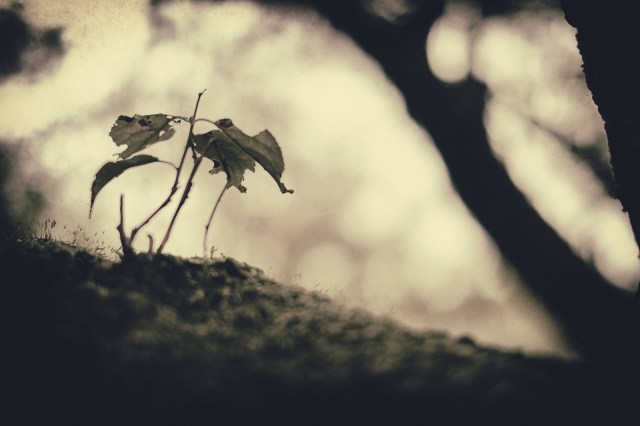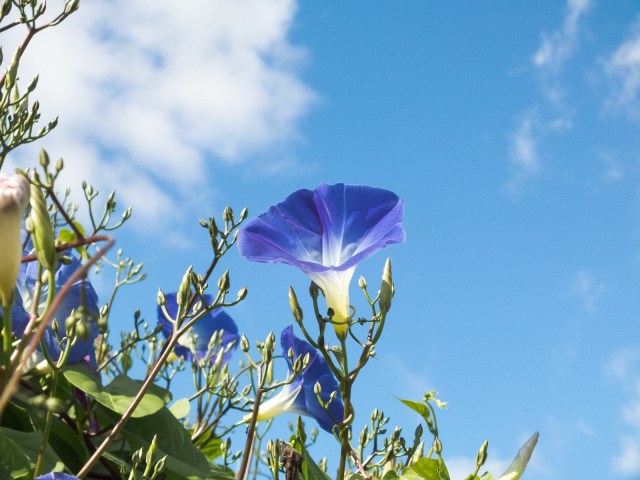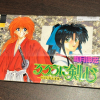
Would a rose by any other name be as dead?
“I’m going to learn the Japanese language!” You announce to yourself, bright-eyed and determined, a fire in your heart and a world of knowledge ahead of you. You studiously pore over hiragana tables, then drill each and every katakana into your head. You learn that Japanese is structured differently from English, that the verb tends to come after the subject and object rather than between them. You tackle a mountain of kanji. Maybe you even find some friends to talk in Japanese with and learn the ebbs and flows of conversation.
Feeling good about yourself, you gesture to a vase filled with ailing morning glories. “Asagao ga kareta.” The morning glories have withered. Right?
…Right?
Wrong! When you address morning glories, or asagao, the correct term to use is shibomu. It also means “to wither”, but has a shriveling, deflating nuance to it.
▼ Here’s a fully blooming morning glory to make you feel better.
As with many aspects of the Japanese language, many native speakers will be far too polite to correct you on the finer points of funereal flower terminology, especially as kareru (the catch-all verb for “wither” or “die” when applied to plants) makes perfect sense in context. But for perfectionists who wish to speak flawless, top-tier Japanese it’s yet another thorn in their side.
YouTuber Artur, who is Latvian but produces content primarily in Japanese, lamented the extent of his withering woes in the following tweet:
他の言語だと『花が枯れる』という表現はそんなに多くないと思うんだけど、日本語の『花が枯れるの表現多すぎ問題』に直面してラトビア人泣いてる。
— アルトゥル📛日本推しラトビア人 (@ArturGalata) March 12, 2021
桜⇒散る
梅⇒こぼれる
椿⇒落ちる
朝顔⇒しぼむ
菊⇒舞う
牡丹⇒崩れる
ま…待ってくれ…
日本人のみんな…
そなた達の語彙力は底なし沼か?
“I feel that other languages don’t have anywhere near as many ways to say the phrase ‘the flower has died’, but the conundrum of having far too many ways to say ‘the flower has died’ in Japanese would reduce a Latvian native to tears.
Cherry blossom ⇒ chiru (falls)
Plum blossom ⇒ koboreru (spills)
Common camellia ⇒ ochiru (drops)
Morning glory ⇒ shibomu (shrivels)
Chrysanthemum ⇒ mau (flutters)
Tree peony ⇒ kuzureru (crumbles)S…Stop, please…
Japanese people…
Is the ravine of your vocabularies truly this bottomless…?”
Each of the verbs listed above—chiru, koboreru, ochiru, shibomu, mau, kuzureru—technically means “to die” in the context of its given flower. In Japanese, just as much importance is given to when a flower shuffles off the mortal coil as to when it blooms, which is why these dying words are so incredibly descriptive—while a cherry blossom falls in death, you wouldn’t describe the ground-rooted morning glory to “fall”. Instead it shrinks in on itself, loses its vivid color, and dies in a tight bundle, so the shriveling aspect of shibomu feels much more appropriate. Likewise, it just feels wrong to describe the fluttering free-fall of dead cherry blossoms as them shriveling.
Common camellia flowers drop dramatically in death, while plum blossoms—similar to cherry blossoms— will spill down from the branches in a shower. The fluttering of chrysanthemums refers to how their sheaves of delicate, willowy petals detach as the plant sickens. Lastly, the tree peony crumbles when it dies in every sense of the word. It loses its pallor, the petals disintegrate. This typically signifies that the branch it grew on needs to be pruned.
Artur apparently came across this unique quirk of language when studying up on the transient art of wabi-sabi; when he realized that blossoms can chiru but autumnal leaves will kareru, he was astounded by the depth and significance of the language involved.
▼ “Japan’s four seasons, especially spring and autumn, are full of wabi-sabi experiences.”
最近は【侘び寂び】を勉強しているのですが、花が散るや紅葉が枯れるなど本当に奥が深いなと驚いてるラトビア人です。
— アルトゥル📛日本推しラトビア人 (@ArturGalata) March 12, 2021
日本の四季、特に春と秋はワビサビを感じる事が多いですね。
🎬【動画】わびさびに取り憑かれた外国人、その本性とは!?
▶https://t.co/l4Lxkov9I3 pic.twitter.com/4CbYr10rxn
The sheer level of descriptive death verbs came as a shock to his many native Japanese fans, as well. The Twitter thread was filled with amusement at how many different terms there were, as well as respect for his determination to learn them all.
“I’m Japanese myself, but even I was astonished at the breadth of phrases. The Japanese language is deep, indeed…”
“Common camellias make a very meaty THUD when they fall, so in the warring Sengoku period, they were considered bad omens. The flower falling with a THUD… It sounds like a head, you know?”
“I don’t think every single Japanese person has these words for flowers dying in their vocabulary, but there sure are a lot.”
“I never knew the terms for plum blossom, chrysanthemum, and tree peony!”
Check out Artur’s YouTube channel for more passionate discoveries like this one, and we have a few things we can teach you, too!
Source: Twitter/@ArturGalata via My Game News Flash
Top image: Pakutaso
Insert image: Pakutaso
● Want to hear about SoraNews24’s latest articles as soon as they’re published? Follow us on Facebook and Twitter!


 We revisited Sweets Paradise after a decade to see if Japan’s dessert buffet still delivers
We revisited Sweets Paradise after a decade to see if Japan’s dessert buffet still delivers Starbucks Japan ready to get Year of the Horse started with adorable drinkware and plushies【Pics】
Starbucks Japan ready to get Year of the Horse started with adorable drinkware and plushies【Pics】 Creator of Rurouni Kenshin anime/manga admits to possession of child pornography
Creator of Rurouni Kenshin anime/manga admits to possession of child pornography Miss World Japan: The great-times-20-granddaughter of samurai lord One-Eyed Dragon
Miss World Japan: The great-times-20-granddaughter of samurai lord One-Eyed Dragon Six uniquely Osaka experiences
Six uniquely Osaka experiences We revisited Sweets Paradise after a decade to see if Japan’s dessert buffet still delivers
We revisited Sweets Paradise after a decade to see if Japan’s dessert buffet still delivers Starbucks Japan ready to get Year of the Horse started with adorable drinkware and plushies【Pics】
Starbucks Japan ready to get Year of the Horse started with adorable drinkware and plushies【Pics】 Creator of Rurouni Kenshin anime/manga admits to possession of child pornography
Creator of Rurouni Kenshin anime/manga admits to possession of child pornography Miss World Japan: The great-times-20-granddaughter of samurai lord One-Eyed Dragon
Miss World Japan: The great-times-20-granddaughter of samurai lord One-Eyed Dragon Six uniquely Osaka experiences
Six uniquely Osaka experiences This ad for Ueno Clinic makes no sense… until you realize what the clinic specializes in【Video】
This ad for Ueno Clinic makes no sense… until you realize what the clinic specializes in【Video】 Uniqlo Ukiyo-e Blue T-shirts: A cool-hued reinterpretation of some of Japan’s greatest paintings
Uniqlo Ukiyo-e Blue T-shirts: A cool-hued reinterpretation of some of Japan’s greatest paintings Japanese group to hold fashion show of colostomy bags and other stoma equipment in Paris
Japanese group to hold fashion show of colostomy bags and other stoma equipment in Paris The etiquette rules for visiting Shinto shrines in Japan
The etiquette rules for visiting Shinto shrines in Japan Family Mart releases a fukubukuro lucky bag packed with cool Convenience Wear
Family Mart releases a fukubukuro lucky bag packed with cool Convenience Wear 7-Eleven Japan’s ramen-cooking robot whipped us up a bowl of noodles【Taste test】
7-Eleven Japan’s ramen-cooking robot whipped us up a bowl of noodles【Taste test】 Cyberpunk anime meets traditional culture in Ghost in the Shell gold leaf Japanese changing screens
Cyberpunk anime meets traditional culture in Ghost in the Shell gold leaf Japanese changing screens 7 great places to see Mt. Fuji from without having to climb it
7 great places to see Mt. Fuji from without having to climb it Hello Kitty Choco Egg figures are an adorable trip through three periods of Japanese pop culture【Pics】
Hello Kitty Choco Egg figures are an adorable trip through three periods of Japanese pop culture【Pics】 Japan’s otoshidama tradition of giving kids money at New Year’s gets a social welfare upgrade
Japan’s otoshidama tradition of giving kids money at New Year’s gets a social welfare upgrade We found possibly the quietest Japanese-style hotel in Tokyo’s bustling Shinjuku district
We found possibly the quietest Japanese-style hotel in Tokyo’s bustling Shinjuku district Lacquerware supplier to emperor of Japan and Pokémon team up for new tableware
Lacquerware supplier to emperor of Japan and Pokémon team up for new tableware Sumo Sanrio! Hello Kitty and pals team up with Japan Sumo Association for new merch【Pics】
Sumo Sanrio! Hello Kitty and pals team up with Japan Sumo Association for new merch【Pics】 Can a dirty butthole make you filthy rich in Japan? We’re starting a New Year’s lottery experiment
Can a dirty butthole make you filthy rich in Japan? We’re starting a New Year’s lottery experiment 7-Eleven Japan starts new temporary luggage storage service in over 300 branches
7-Eleven Japan starts new temporary luggage storage service in over 300 branches Disillusionment at Tsukiji’s tourist-target prices led us to a great ramen restaurant in Tokyo
Disillusionment at Tsukiji’s tourist-target prices led us to a great ramen restaurant in Tokyo Starbucks teams up with 166-year-old Kyoto doll maker for Year of the Horse decorations【Photos】
Starbucks teams up with 166-year-old Kyoto doll maker for Year of the Horse decorations【Photos】 Tokyo considering law requiring more trash cans following litter increase in heavily touristed area
Tokyo considering law requiring more trash cans following litter increase in heavily touristed area Tokyo’s Tsukiji sushi neighborhood asks tour groups to stay away for the rest of the month
Tokyo’s Tsukiji sushi neighborhood asks tour groups to stay away for the rest of the month Nintendo’s Kirby now delivering orders at Kura Sushi restaurants, but not in Japan
Nintendo’s Kirby now delivering orders at Kura Sushi restaurants, but not in Japan Tokyo event lets you travel back in time, for free, to celebrate 100 years since Showa era start
Tokyo event lets you travel back in time, for free, to celebrate 100 years since Showa era start Sanrio theme park in Japan announces plans to expand into a Sanrio resort
Sanrio theme park in Japan announces plans to expand into a Sanrio resort Japan may add Japanese language proficiency, lifestyle classes to permanent foreign resident requirements
Japan may add Japanese language proficiency, lifestyle classes to permanent foreign resident requirements Survey asks foreign tourists what bothered them in Japan, more than half gave same answer
Survey asks foreign tourists what bothered them in Japan, more than half gave same answer Japan’s human washing machines will go on sale to general public, demos to be held in Tokyo
Japan’s human washing machines will go on sale to general public, demos to be held in Tokyo Japan’s deadliest food claims more victims, but why do people keep eating it for New Year’s?
Japan’s deadliest food claims more victims, but why do people keep eating it for New Year’s? We deeply regret going into this tunnel on our walk in the mountains of Japan
We deeply regret going into this tunnel on our walk in the mountains of Japan Studio Ghibli releases Kodama forest spirits from Princess Mononoke to light up your home
Studio Ghibli releases Kodama forest spirits from Princess Mononoke to light up your home Major Japanese hotel chain says reservations via overseas booking sites may not be valid
Major Japanese hotel chain says reservations via overseas booking sites may not be valid Put sesame oil in your coffee? Japanese maker says it’s the best way to start your day【Taste test】
Put sesame oil in your coffee? Japanese maker says it’s the best way to start your day【Taste test】 No more using real katana for tourism activities, Japan’s National Police Agency says
No more using real katana for tourism activities, Japan’s National Police Agency says Starbucks Japan reveals new sakura drinkware collection, inspired by evening cherry blossoms
Starbucks Japan reveals new sakura drinkware collection, inspired by evening cherry blossoms Updated cherry blossom forecast shows extra-long sakura season for Japan this year
Updated cherry blossom forecast shows extra-long sakura season for Japan this year This ad for Ueno Clinic makes no sense… until you realize what the clinic specializes in【Video】
This ad for Ueno Clinic makes no sense… until you realize what the clinic specializes in【Video】 Uniqlo Ukiyo-e Blue T-shirts: A cool-hued reinterpretation of some of Japan’s greatest paintings
Uniqlo Ukiyo-e Blue T-shirts: A cool-hued reinterpretation of some of Japan’s greatest paintings Japanese group to hold fashion show of colostomy bags and other stoma equipment in Paris
Japanese group to hold fashion show of colostomy bags and other stoma equipment in Paris The etiquette rules for visiting Shinto shrines in Japan
The etiquette rules for visiting Shinto shrines in Japan Family Mart releases a fukubukuro lucky bag packed with cool Convenience Wear
Family Mart releases a fukubukuro lucky bag packed with cool Convenience Wear Hey, Japanese taxi driver! Take us to the best Turkish rice restaurant in Nagasaki!
Hey, Japanese taxi driver! Take us to the best Turkish rice restaurant in Nagasaki! Cosplay at the beach with new range of beautiful Japanese maid uniform bikini sets
Cosplay at the beach with new range of beautiful Japanese maid uniform bikini sets Japanese Railway Lost Property Market: A treasure trove of lost items from trains
Japanese Railway Lost Property Market: A treasure trove of lost items from trains Conveyor belt yakiniku: Our new favourite way to enjoy all-you-can-eat meat in Japan
Conveyor belt yakiniku: Our new favourite way to enjoy all-you-can-eat meat in Japan Princesses, fruits, and blacksmiths: Study reveals the 30 most unusual family names in Japan
Princesses, fruits, and blacksmiths: Study reveals the 30 most unusual family names in Japan Starbucks Japan unveils new limited-edition Christmas menu at Reserve Roastery Tokyo
Starbucks Japan unveils new limited-edition Christmas menu at Reserve Roastery Tokyo Beautiful Studio Ghibli photo frames let you put yourself in the worlds of Totoro and Kiki【Pics】
Beautiful Studio Ghibli photo frames let you put yourself in the worlds of Totoro and Kiki【Pics】 Can we really become YouTubers with the Thanko YouTuber Debut fukubukuro lucky bag?
Can we really become YouTubers with the Thanko YouTuber Debut fukubukuro lucky bag? This Tokyo temple offers breakfast that’s beautiful, delicious, and includes message of salvation
This Tokyo temple offers breakfast that’s beautiful, delicious, and includes message of salvation
Leave a Reply